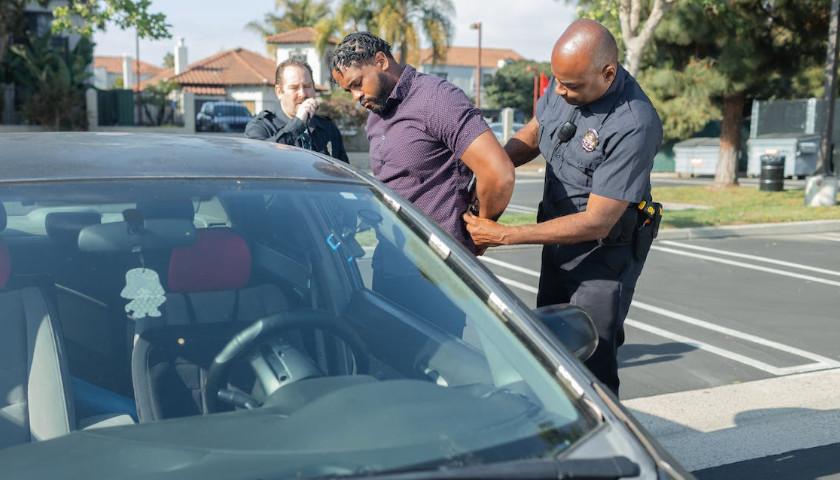
An open letter to the gun community from HK’s marketing department: In a world of compromises, some people put the bullets in the magazine backwards…But it doesn’t matter, because our gun is on the cover of the Rainbow Six video games. Look how cool that SEAL coming out of the water looks… If you buy a $2,000 SOCOM, you will be that cool of an operator too. And chicks will dig you.
At HK, we stuck a piston on an AR15, just like a bunch of other companies have done, dating back to about 1969. However ours is better, because we refuse to sell it to civilians. Because you suck, and we hate you.
Our XM8 is the greatest rifle ever developed. It may melt, and it doesn’t fit any accessories known to man, but that is your fault. If you were a real operator, you would love it. Once again, look at Rainbow Six, that G36 sure is cool isn’t it? Yeah, you know you want one.
And by the way, check out our new HK45. We decided that humans don’t need to release the magazine with their thumbs. If you were a really manly teutonic operator, you would be able to reach the controls. Plus we’ve fired 100,000,000 rounds through one with zero malfunctions, and that was while it was buried in a lake of molten lava, on the moon. If you don’t believe us, it is because you aren’t a real operator.
By the way, our cheap, mass-produced, stamped sheet metal guns like the G3 and MP5 are the bestest things ever, and totally worth asinine scalpers prices, but note that cheap, mass-produced, stamped sheet metal guns from other countries are commie garbage. Not that it matters, because you’re civilians, so we won’t sell them to you anyway. Because you suck, and we hate you, but we know you’ll be back. We can beat you down like a trailer park wife, but you’ll come back, you always do.
Buy our stuff.
Sincerely
HK Marketing DepartmentHK. Because you suck. And we hate you.
I don’t know if you can tell, but I’m not the biggest fan of H und K. I posted that letter on THR a long time ago as a joke, but it sure did manage to tick a lot of people off. Ironically, the tag line, HK. Because you suck. And we hate you, has been popping up in various places ever since.
Sure, they’re decently reliable, decently accurate guns, but they’re massively overpriced and overrated by legions of fan boys. One of the most frustrating things about dealing with gun people on the interweb is that folks tend to pick a brand, and then base some of their self-esteem on that brand.
Kind of like rabid sports fans who feel the need to burn cars if their team wins, or loses, or they just felt like burning stuff. Say something negative about that team to one of those rabid fans, and you’re probably going to get beat up. Likewise, if you say anything negative about the Teutonic superiority of HK, people get mad at you.
Well, I love hate mail, so here goes.
For each of their wunder guns, you can get something else that costs a lot less, and works better, and has ergonomics designed by people that actually shoot. HK came about when some Nazis fled to Spain and built the Cetme.
But Cetme doesn’t sound very tough, does it? So they went back to Germany and became H and K, and if you call it H and K, fan boys will get mad, and insist that it is HK, because manly Teutonic operators and Navy SEALs don’t have time to say the word And. So HK rose to prominence by building the G3, which is what the Germans call the Cetme.
Now the G3 is a decent rifle. It is a cheap, stamped sheet metal, battle rifle. It has terrible ergonomics, with a hard to use safety, (and this is coming from a guy with gorilla hands), and difficult to use charging handle. It is reliable, because of the roller locking bolt that destroys your brass, and recoils worse than other competing .308 rifles. The FAL smokes the G3, and the only reason the G3 exists is because the Germans were too proud to pay royalties to those uppity Belgians.
The G3 can be really accurate, if you weld a bunch of metal to the sides of it, stick on a nice barrel, and jack the price up $10,000. And no, that’s not a typo. The PSG1 is absurdly priced, and the cheaper version, the MSG90 is proof that if make anything absurdly heavy enough, it can be accurate.
There is a collapsible stock available, which is awesome, if you like getting hit in the face with a piece of rebar, which is what their $400 stock feels like when you shoot it. Germans must be tougher than we are or something.
Other stamped, sheet metal guns exist, but HK fan boys mock those as commie garbage. See, if you build a cheap gun, but it is from Germany, then it is superior, but if you build a stamped gun in the eastern block (a hundred miles from Germany) then it is commie garbage.
But what brought HK to international fame and the cover of Dick Marcinko books (for example, Rogue Force Delta Green Team 7 Ninja Force Alpha II: The beginning) was the G3s little brother, the MP5. Take a G3, shrink it, and chamber it in 9mm. At the time, CQB doctrine was to use 9mm subguns. Now the MP5 is a neat little gun. I have two. They work well, and if compared to the other subguns of the day, like the Uzi or the Mac, then the MP5 was a lot easier to use, easier to hit with, and was decently reliable.
The MP5 became famous when the SAS used them to kick the living hell out of some bad guys at the Iranian embassy. This was marketing gold, and HK rode the wave. Pretty soon everybody wanted an MP5. It was what all the cool kids were using. Soon every video game and action movie was filled with HK stuff. HK may have overrated guns, but they’ve got the best marketing department in the gun business, and they milked that fee cow until it was dry.
But the MP5 isn’t as great as people make them out to be. They still malfunction. (if you’re favorite gun hasn’t malfed, you haven’t shot it enough). The mags are hard to insert on a closed bolt. Safety still sucks. Most versions don’t have a bolt hold open. Honestly, if I had to get into a gunfight with a subgun, then I would rather have my PPsH.
HK long guns were mostly unobtainable to US civilians, primarily because HK hates the civilian market. If you don’t believe me, go talk to them at SHOT show, and watch them sneer at regular people. They can’t help themselves. But like all unobtainable things, like Ferraris, and super models, regular folks start to imagine these unobtainable things as perfection, when really they’re just an expensive car that spends most of its time in the shop, or a chick with mental problems and Bulimia. That’s what happened with HK. Their products took on this aura of coolness amongst the fans, that just isn’t real.
For example, go to any thread on the internet where somebody brings up “What is the Best Rifle EVAR!” and there is a poll. On the poll will be some HK long guns that 99.85% of the gun owning public has never seen, let alone shot, but those guns will have the most votes, because the HK marketing department told you how awesome they are.
Read up about the XM8 on most gun boards. According to the interweb, the XM8 is the finest combat implement of all time. In actuality it is a plastic AR18, that tends to melt, break, and is universally loathed by the Army staff that had to test it. It takes bizarre attachments, so no US accessories will work. They took the G36, which is basically a blah rifle, used by a handful of countries that don’t ever actually shoot people, and uglied it up so that it looks like the demented lovechild of Bloaty the Pizza Hog and a Super-Soaker.
Or the HK416. According to the internet, the HK416 is the best gun EVER! It is called THE AWESOME. Lightning bolts of coolness fly from the gun and smite your enemies with Teutonic fury! However you can’t have one, because you’re a civilian, ergo, you suck. And HK hates you.
The 416 is basically an AR with a gas piston, which has been done by like ten companies now, but somehow the HK is better, because it was on Future Weapons, and HK won’t sell it to civilians. In fact, a couple of 416s slipped out into civilian hands, and HK freaked out about it. There is no legal reason that 416 uppers can’t be sold, but HK despises regular people, and the idea of you having their long guns offends them.
You can get civilian HK long guns, once in a while, when HK feels like it, but they’re usually hyper-neutered and over priced. Hell, the last ones were actually grey, because you know, black is too dangerous, or something.
HK’s new subgun is the UMP. They tend to break. One of our local PDs traded all of theirs in after they broke all the stocks. Cool idea, because everybody loves .45, but bad execution.
HK’s flagship pistols, the USP line, are decent polymer handguns. They are extremely reliable, that is the plus side. On the down side, their triggers universally suck, but they don’t have to. HK likes to use a square peg in a round hole, (literally) that makes the trigger pull a lot heavier and grittier than it needs to be. Why? Beats the heck out of me. The USP series should be reliable, they’re enormous.
The most annoying thing about the HK pistols is how they cost almost twice as much as every other polymer handgun on the market. Somehow being made in Germany means the USP series is worth $800-$1000, when all of the polymer guns made within a thousand miles are $400-$600. Only most of those guns tend to have better triggers, are just as reliable, and are usually more accurate.
Then there is the Mk23. Which is huge, accurate, reliable, (which it damn well better be, since it is the size and weight of a Mini-14) costs as much as a used car, huge, and is universally despised by the SF that it is issued to. Talk to anyone that is in an SF unit. The Mk23s they’ve been issued sit unused in arms room. Did I mention that it is HUGE? But that’s okay, because the HK fan boys will explain that it is an OFFENSIVE handgun. (scratches head) whatever the hell that is supposed to mean.
They are reliable, but so is a $125 Makarov. Only the Mak has a better trigger.
I have two guys that I work with that have been to the HK armorer’s school. If you think I’m biased, you should talk to them. They especially love working with the Germans. One fellow was yelled at because he had two magazines clamped together on his MP5, because “NEIN! That is not the H und K way!” Even though he had bought the mag clamp from HK. When you ask why the original MP5 doesn’t have a last shot bolt hold open, they’ll yell at you and say, “NEIN! Why would you want your enemy to know your gun is empty!” Hell, Hans, I just want to know when my gun is empty!
One friend of mine took his personal MP5, and cut an extra notch into the collapsible stock, so it would be shorter for when he was wearing his armor, and also it removed the nasty wobble that all HK collapsible stocks have. It is an easy fix, and a no-brainer that the HK should have been doing for years. Fritz at the armorer’s school damn near had an aneurism when he saw this blasphemy against his ineffectual German gods.
Look, gun owning public, just because you saw it on Future Weapons, or read about it on the internet, doesn’t make it true. For the love of John Moses Browning, before you formulate super strong opinions about a weapon, you should have at least shot the damn thing first.
Do I have anything positive to say about HK? Yes, the sneer of disdain they give you at SHOT is priceless and entertaining.
Edit: My book, Monster Hunter International, is available now on Amazon. http://www.amazon.com/gp/product/0741444569/ref=s9_asin_title_wishf_r4-f9_p_c_f_p-2785_g1?ie=UTF8&coliid=I1EXBBDFCRIV04&colid=3QAUVGDWI48Y7&pf_rd_m=ATVPDKIKX0DER&pf_rd_s=right-4&pf_rd_r=0YJY8KAT16R6R571HXSP&pf_rd_t=101&pf_rd_p=362209101&pf_rd_i=507846





























